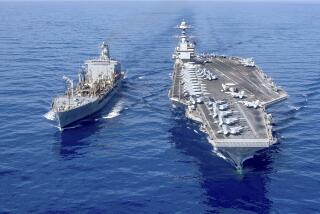Eisenhower, master of the Middle East
- Share via
The Middle East will undoubtedly continue to be unstable. Its legacy of colonialist exploitation, badly drawn borders, decades of power struggles, the scramble for oil and, since 1948, the Arab-Israeli conflict has ensured a rocky future. For every American president, the question is not whether but when and where the next Middle East crisis will erupt.
As President Obama considers his options in the region, which president should he look to as a model for effective leadership in the Middle East? Ronald Reagan is the favorite of pundits these days, but Reagan’s actions in the Middle East bordered on disastrous.
Following the Israeli invasion of Lebanon in 1982, Reagan landed a token military force that set the stage for the deaths of 241 U.S. Marines in a terrorist attack on their U.S. barracks at the Beirut airport. He climaxed a confusing policy toward Libya with a two-day bombing campaign in 1986 that left Moammar Kadafi in power stronger than ever. Reagan betrayed his own policy of not bargaining with terrorists when his administration sold antitank and antiaircraft missiles to Iran to secure the release of American hostages in Lebanon, and then used the proceeds to secretly arm the Contra rebels in Nicaragua.
A better president to emulate is Dwight D. Eisenhower. Like every president since World War II, Ike confronted the unexpected in the Middle East, but he was ready, having hammered out his principles and priorities in advance. Eisenhower captured his approach in a maxim: “Plans are worthless — but planning is everything.” His planning process examined multiple contingencies and meticulously defined policy goals so that he, as president, could “do the normal thing when everybody else is going nuts.”
In 1956, Eisenhower confronted the most dangerous international crisis of his presidency. The trigger was Egyptian President Gamal Abdel Nasser’s nationalization of the Suez Canal that July. Two-thirds of the oil for Western Europe transited the canal. To the British and French, its seizure was calamitous. As they prepared for war, Eisenhower refused to permit his historical allies or Israel to dictate American policy. Instead, he defended Egypt’s right to nationalize the canal and pushed for a peaceful solution.
On election day, Nov. 6, 1956, Eisenhower faced a perfect Middle East storm. Nine days earlier, without consulting Ike, Israel had attacked Egypt, and British and French forces had followed suit days later. The previous day the Soviet Union, fresh from the bloody repression of a revolt in Hungary, had threatened to intervene in the conflict. In response, Eisenhower sternly warned the Soviets against such action and placed American forces on alert.
Throughout the crisis, Eisenhower courageously denied desperately needed cash and petroleum to the allies, saying they could “boil in their own oil” until they agreed to a cease-fire and withdrawal from Egypt. Remarkably, on election day, he won reelection by a landslide and secured an end to the fighting.
After the Suez crisis, Eisenhower persuaded Congress to pass a program of economic and military aid to Middle East nations. In the Eisenhower Doctrine, the president committed the United States to replacing Britain as the guarantor of stability and security in the Middle East. That obligation remains the cornerstone of American policy.
Ike abhorred token, fragmented military operations like Reagan’s, contending that any military intervention should employ overwhelming force. Lebanon provides a useful comparison. Unlike Reagan’s botched operation in 1982, Ike implemented his doctrine by landing 14,000 troops in Lebanon in 1958 in a virtually bloodless show of force.
Above all, Eisenhower embraced the tides of history. He pressed America’s allies to bury the corpse of colonialism in the Middle East. Today, we need the equivalent — a rigorously defined, clear-headed commitment to democratic movements that avoids the ad-hocracy of Reagan and his successors.
As Ike said, and as is inscribed on the wall of the Eisenhower Museum in Abilene, Kan.: “The United States never lost a soldier or a foot of ground during my administration. We kept the peace. People ask how it happened — by God, it didn’t just happen.”
David A. Nichols is an authority on the Eisenhower presidency and the author of the just-released book “Eisenhower 1956: The President’s Year of Crisis — Suez and the Brink of War.”
More to Read
A cure for the common opinion
Get thought-provoking perspectives with our weekly newsletter.
You may occasionally receive promotional content from the Los Angeles Times.









